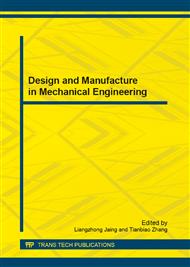[1]
O. Lambercy, L. Dovat, R. Gassert, E. Burdet, C.L. Teo, and T. Milner: A haptic knob for rehabilitation of hand function, Neural Systems and Rehabilitation Engineering, IEEE Transactions on, vol. 15 (2007), pp.356-366.
DOI: 10.1109/tnsre.2007.903913
Google Scholar
[2]
D.J. Reinkensmeyer, J.A. Galvez, L. Marchal, E.T. Wolbrecht, and J.E. Bobrow: Some key problems for robot-assisted movement therapy research: A perspective from the University of California at Irvine, in Rehabilitation Robotics, 2007. ICORR 2007. IEEE 10th International Conference on, (2007).
DOI: 10.1109/icorr.2007.4428547
Google Scholar
[3]
T. Nef, M. Mihelj, G. Kiefer, C. Perndl, R. Muller, and R. Riener: ARMin-Exoskeleton for arm therapy in stroke patients, in Rehabilitation Robotics, 2007. ICORR 2007. IEEE 10th International Conference on, (2007), pp.68-74.
DOI: 10.1109/icorr.2007.4428408
Google Scholar
[4]
N. Hogan, H.I. Krebs, J. Charnnarong, P. Srikrishna, and A. Sharon: MIT-MANUS, a workstation for manual therapy and training. I, in Robot and Human Communication, 1992. Proceedings., IEEE International Workshop on, (1992), pp.161-165.
DOI: 10.1109/roman.1992.253895
Google Scholar
[5]
R. Holt, S. Makower, A. Jackson, P. Culmer, M. Levesley, R. Richardson, A. Cozens, M. M Williams, and B. Bhakta: User involvement in developing Rehabilitation Robotic devices: An essential requirement, in Rehabilitation Robotics, 2007. ICORR 2007. IEEE 10th International Conference on, (2007).
DOI: 10.1109/icorr.2007.4428427
Google Scholar
[6]
R.C.V. Loureiro and W.S. Harwin: Reach & grasp therapy: design and control of a 9-DOF robotic neuro-rehabilitation system, in Rehabilitation Robotics, 2007. ICORR 2007. IEEE 10th International Conference on Rehabilitation Robotics, (2007).
DOI: 10.1109/icorr.2007.4428510
Google Scholar
[7]
J.S. Sulzer, M.A. Peshkin, and J.L. Patton: Design of a Mobile, Inexpensive Device for Upper Extremity Rehabilitation at Home, in Rehabilitation Robotics, 2007. ICORR 2007. IEEE 10th International Conference on, (2007), pp.933-937.
DOI: 10.1109/icorr.2007.4428535
Google Scholar
[8]
I. Lindgren, A.C. Jönsson, B. Norrving, and A. Lindgren: Shoulder pain after stroke A prospective population-based study, Stroke, vol. 38 (2007), pp.343-348.
DOI: 10.1161/01.str.0000254598.16739.4e
Google Scholar
[9]
L. Dovat, O. Lambercy, V. Johnson, B. Salman, S. Wong, R. Gassert, E. Burdet, T.C. Leong, and T. Milner: A cable driven robotic system to train finger function after stroke, in Rehabilitation Robotics, 2007. ICORR 2007. IEEE 10th International Conference on, (2007).
DOI: 10.1109/icorr.2007.4428430
Google Scholar
[10]
W. Abend, E. Bizzi, and P. Morasso: Human arm trajectory formation, Brain: a journal of neurology, vol. 105 (1982), p.331.
DOI: 10.1093/brain/105.2.331
Google Scholar
[11]
C.F. Yeong, A. Melendez-Calderon, and E. Burdet: Analysis of pick-and-place, eating and drinking movements for the workspace definition of simple robotic devices, in Rehabilitation Robotics, 2009. ICORR 2009. IEEE International Conference on, (2009).
DOI: 10.1109/icorr.2009.5209475
Google Scholar
[12]
L.E. Kahn, M.L. Zygman, W.Z. Rymer, and D.J. Reinkensmeyer: Effect of robot-assisted and unassisted exercise on functional reaching in chronic hemiparesis, in Engineering in Medicine and Biology Society, 2001. Proceedings of the 23rd Annual International Conference of the IEEE, (2001).
DOI: 10.1109/iembs.2001.1020445
Google Scholar
[13]
C.F. Yeong, A. Melendez-Calderon, R. Gassert, and E. Burdet: ReachMAN: a personal robot to train reaching and manipulation, in Intelligent Robots and Systems, 2009. IROS 2009. IEEE/RSJ International Conference on, (2009), pp.4080-4085.
DOI: 10.1109/iros.2009.5354837
Google Scholar
[14]
B.H. Dobkin: Rehabilitation after stroke, New England Journal of Medicine, vol. 352 (2005), pp.1677-1684.
Google Scholar


